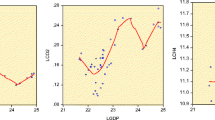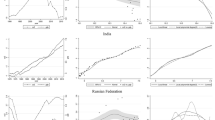Abstract
This study examines the association between air pollution and economic growth based on the idea of environment Kuznets curve (EKC) hypothesis which suggests an inverted U-shaped link between air pollution and economic growth in six different regions including Latin America and the Caribbean, East Asia and the Pacific, Europe and Central Asia, South Asia, the Middle East and North Africa, and Sub-Saharan Africa over the period 2000 to 2018. This regional classification is done to investigate the regional differences of the EKC relationship for carbon emissions. Models based on panel data econometric models are employed to obtain empirical results. Random effect and fixed effect models are used in the present study. A multivariate framework is used in which carbon dioxide emission, per capita gross domestic product, trade openness, foreign direct investment, primary school enrollment, financial development indicator, and institutional quality that is measured by six indicators are included. The result is that the EKC hypothesis is supported in all the abovementioned regions except in the Sub-Saharan Africa region. Thus, the hypothesis that different regions have dissimilar EKC relationships is supported through the results of this research study.


Similar content being viewed by others
Data Availability
Data are available at the International Energy Agency (IEA), International Monetary Fund, World Governance Indicator (WGI), and World Development Indicator (WDI).
References
Abid M (2016) Impact of economic, financial, and institutional factors on CO2 emissions: evidence from Sub-Saharan Africa economies. Util Policy 41:1–10
Ahmed K, Long W (2012) Environmental Kuznets curve and Pakistan: an empirical analysis. Procedia Econ Finance 1:4–13
Al-Mulali U, Tang CF, Ozturk I (2015) Estimating the environment Kuznets curve hypothesis: evidence from Latin America and the Caribbean countries. Renew Sust Energ Rev 50:918–924
Anastacio JAR (2017) Economic growth, CO2 emissions and electric consumption: is there an environmental Kuznets curve? An empirical study for North America countries. Int J Energy Econ Policy 7(2):65–71
Andreoni J, Levinson A (2001) The simple analytics of the environmental Kuznets curve. J Public Econ 80(2):269–286
Antweiler W, Copeland BR, Taylor MS (2001) Is free trade good for the environment? Am Econ Rev 91(4):877–908
Apergis N, Ozturk I (2015) Testing environmental Kuznets curve hypothesis in Asian countries. Ecol Indic 52:16–22
Ayeche MB, Barhoumi M, Hammas MA (2016) Causal linkage between economic growth, financial development, trade openness and CO2 emissions in European countries. Am J Environ Eng 6(4):110–122
Balaguer J, Cantavella M (2018) The role of education in the Environmental Kuznets curve. Evidence from Australian data. Energy Econ 70:289–296
Chen Y, Wang Z, Zhong Z (2019) CO2 emissions, economic growth, renewable and non-renewable energy production and foreign trade in China. Renew Energy 131:208–216
Cho CH, Chu YP, Yang HY (2014) An environment Kuznets curve for GHG emissions: a panel cointegration analysis. Energy Sources B Econ Plan Policy 9(2):120–129
Constantinescu C (2014) Valuing interdependence of education, trade and the environment for the achievement of sustainable development. Procedia Soc Behav Sci 116:3340–3344
Dasgupta S, Laplante B, Wang H, Wheeler D (2002) Confronting the environmental Kuznets curve. J Econ Perspect 16(1):147–168
Dinda S (2005) A theoretical basis for the environmental Kuznets curve. Ecol Econ 53(3):403–413
Dong K, Sun R, Jiang H, Zeng X (2018) CO2 emissions, economic growth, and the environmental Kuznets curve in China: what roles can nuclear energy and renewable energy play? J Clean Prod 196:51–63
Duy LN (2010) The impact of trade liberalization on the environment in some East Asian countries: an empirical study. 22nd CEA annual conference at Oxford University
El Alaoui A (2015) What is the relationship between environmental quality, economic growth and free trade? Int J Soc Sci Educ Res 3(1):124–144
Elmarzougui E, Larue B, Tamini LD (2016) Trade openness, domestic and foreign investments, and the environment. Mod Econ 7(5):591–605
Grossman GM, Krueger AB (1991) Environmental impacts of a North American Free Trade Agreement. (No. w3914). National Bureau of Economic Research
Grossman GM, Krueger AB (1995) Economic growth and the environment. Q J Econ 110(2):353–377
Harbaugh WT, Levinson A, Wilson DM (2002) Reexamining the empirical evidence for an environmental Kuznets curve. Rev Econ Stat 84(3):541–551
Holtz-Eakin D, Selden TM (1995) Stoking the fires? CO2 emissions and economic growth. J Public Econ 57:85–101
Hosseini HM, Kaneko S (2013) Can environmental quality spread through institutions? Energy Policy 56:312–321
Jabeen A (2015) Is trade liberalization, economic growth, energy consumption good for the environment? Roman J Fisc Policy 6(2):1–13
Jalil A, Mahmud SF (2009) Environment Kuznets curve for CO2 emissions: a cointegration analysis for China. Energy Policy 37(12):5167–5172
Lee CC, Chiu YB, Sun CH (2010) The environmental Kuznets curve hypothesis for water pollution: do regions matter? Energy Policy 38(1):12–23
Li S, Zhang J, Ma Y (2015) Financial development, environmental quality and economic growth. Sustainability 7:9395–9416
Mousavi SK (2015) The effect of trade liberalization on the quality of the environment in both developed and developing countries. Indian J Fundam Appli Life Sci 5:2894–2902
Nasir M, Rehman FU (2011) Environmental Kuznets curve for carbon emissions in Pakistan: an empirical investigation. Energy Policy 39(3):1857–1864
Oh J, Yun C (2014) Environment Kuznets curve revisited with special reference to Eastern Europe and Central Asia. Int Area Stud Rev 17:359–374
Omri A, Daly S, Rault C, Chaibi A (2015) Financial development, environmental quality, trade and economic growth: what causes what in MENA countries. Energy Econ 48:242–252
Ozatac N, Gokmenoglu KK, Taspinar N (2017) Testing the EKC hypothesis by considering trade openness, urbanization, and financial development: the case of Turkey. Environ Sci Pollut Res 24(20):16690–16701
Özokcu S, Özdemir Ö (2017) Economic growth, energy, and environmental Kuznets curve. Renew Sust Energ Rev 72:639–647
Panayotou T (1993) Empirical tests and policy analysis of environmental degradation at different stages of economic development. (No. 238). International Labour Organization
Pata UK (2018) The influence of coal and noncarbohydrate energy consumption on CO2 emissions: revisiting the environmental Kuznets curve hypothesis for Turkey. Energy 160:1115–1123
Rabbi F, Akbar D, Kabir SZ (2015) Environment Kuznets curve for carbon emissions: a cointegration analysis for Bangladesh. Int J Energy Econ Policy 5(1):45–53
Ren S, Yuan B, Ma X, Chen X (2014) International trade, FDI (foreign direct investment) and embodied CO2 emissions: a case study of Chinas industrial sectors. China Econ Rev 28:123–134
Saboori B, Sulaiman J, Mohd S (2016) Environmental Kuznets curve and energy consumption in Malaysia: a cointegration approach. Energy Sources B Econ Plan Policy 11(9):861–867
Sarkodie SA, Strezov V (2019) Effect of foreign direct investments, economic development and energy consumption on greenhouse gas emissions in developing countries. Sci Total Environ 646:862–871
Selden TM, Song D (1994) Environmental quality and development: is there a Kuznets curve for air pollution emissions? J Environ Econ Manag 27(2):147–162
Shafik N, Bandyopadhyay S (1992) Economic growth and environmental quality: time-series and cross-country evidence. (No. wps 904). World Development Report
Shahbaz M, Lean HH, Shabbir MS (2012) Environmental Kuznets curve hypothesis in Pakistan: cointegration and Granger causality. Renew Sust Energ Rev 16(5):2947–2953
Shahbaz M, Ozturk I, Afza T, Ali A (2013) Revisiting the environmental Kuznets curve in a global economy. Renew Sust Energ Rev 25:494–502
Shahbaz M, Mallick H, Mahalik MK, Loganathan N (2015) Does globalization impede environmental quality in India? Ecol Indic 52:379–393
Shahbaz M, Shahzad SJH, Ahmad N, Ahmad S (2016) Financial development and environmental quality: the way forward, MPRA Paper No. 73394, 1-29
Zafar F, Anwar S, Hussain Z, Ahmad N (2013) Impact of trade liberalization and corruption on environmental degradation in Pakistan. J Financ Econ 1(4):84–89
Zambrano-Monserrate MA, Silva-Zambrano CA, Davalos-Penafiel JL, Zambrano-Monserrate A, Ruano MA (2018) Testing environmental Kuznets curve hypothesis in Peru: the role of renewable electricity, petroleum and dry natural gas. Renew Sust Energ Rev 82:4170–4178
Zuo H, Ai D, Lin Y (2017) Foreign trade and pollution: the case of South China water quality. In: IOP Conference Series: Earth and Environmental Science, 52(1), 1-7, vol 52. IOP Publishing, p 012074
Author information
Authors and Affiliations
Contributions
Both authors contributed to the study conception and design. Material preparation, data collection, and analysis were performed by Fatima Bibi and Muhammad Jamil. The first draft of the manuscript was written by Fatima Bibi. Both of us read and approved the final manuscript.
Corresponding author
Ethics declarations
Conflicts of interests
The authors declare that they have no competing interests.
Ethical approval
Not applicable
Consent for publication
Not applicable
Additional information
Responsible editor: Nicholas Apergis
Publisher’s note
Springer Nature remains neutral with regard to jurisdictional claims in published maps and institutional affiliations.
Appendix
Appendix
Rights and permissions
About this article
Cite this article
Bibi, F., Jamil, M. Testing environment Kuznets curve (EKC) hypothesis in different regions. Environ Sci Pollut Res 28, 13581–13594 (2021). https://doi.org/10.1007/s11356-020-11516-2
Received:
Accepted:
Published:
Issue Date:
DOI: https://doi.org/10.1007/s11356-020-11516-2
Keywords
- Environment Kuznets curve (EKC)
- Panel data estimation
- Carbon dioxide emission
- Geographic analysis
- Economic development




